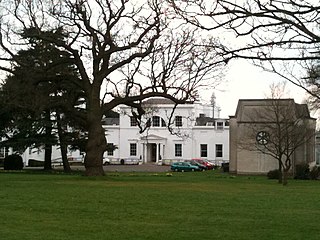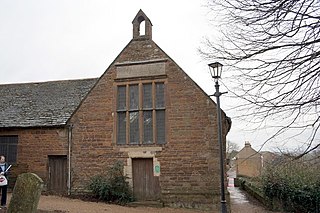
Cleveland is a land of hills and dales from the River Tees to Vale of Pickering, England. The name means “cliff-land”.

An archdeacon is a senior clergy position in the Church of the East, Chaldean Catholic Church, Syriac Orthodox Church, Anglican Communion, St Thomas Christians, Eastern Orthodox churches and some other Christian denominations, above that of most clergy and below a bishop. In the High Middle Ages it was the most senior diocesan position below a bishop in the Catholic Church. An archdeacon is often responsible for administration within an archdeaconry, which is the principal subdivision of the diocese. The Oxford Dictionary of the Christian Church has defined an archdeacon as "A cleric having a defined administrative authority delegated to him by the bishop in the whole or part of the diocese." The office has often been described metaphorically as oculus episcopi, the "bishop's eye".

Oak Hill College is a conservative evangelical theological college located on Chase Side in Southgate, London, England. Its aim is to prepare men and women from the Church of England and Independent churches for ministry in the real world.

Robert Johnson was a Church of England cleric and the founder of both Oakham School and Uppingham School.

The Diocese of Ballarat is a diocese of the Anglican Church of Australia, which was created out of the Diocese of Melbourne in 1875. It is situated in the Ballarat region of the state of Victoria, Australia and covers the south-west region of the state. The diocesan cathedral is the Cathedral of Christ the King in Ballarat. Garry Weatherill, formerly the Bishop of Willochra between 2000 and 2011, was installed as the 10th Bishop of Ballarat on 5 November 2011.

Charles Moss was an Anglican clergyman who served as Bishop of St David's from 1766 to 1774 and Bishop of Bath and Wells from 1774 to 1802.
Robert Wilmer Woods,, known as Robin Woods, was an English Anglican bishop. He was the Bishop of Worcester from 1971 to 1982. He previously served as Archdeacon of Sheffield from 1958 to 1962, and as Dean of Windsor from 1962 to 1970.
The Archdeacon of West Cumberland is responsible for the archdeaconry of West Cumberland, one of three administrative divisions of the Church of England (Anglican) Diocese of Carlisle. The archdeaconry was created by Order-in-Council on 7 August 1959.

Michael Arthur Hill is an English Anglican bishop. He was the Bishop of Bristol from 2003 until he retired effective 30 September 2017.
Samuel Squire was a Bishop of the Church of England and a historian.
The Archdeacon of Bath is a senior ecclesiastical officer in the Church of England Diocese of Bath and Wells. The post, having oversight over the archdeaconry of Bath, has existed since the twelfth century. The archdeaconry includes five deaneries.
The Ven. Charles Thomas Wilkinson, DD was an Anglican priest: the Archdeacon of Totnes from 1888 until his death.
Samuel Cheetham , DD, FSA was an eminent Anglican priest and author in the last quarter of the nineteenth century and the first decade of the twentieth.
The Ven. Justly Hill was the Archdeacon of Buckingham from 1825 until 1853.
William Pollock was Archdeacon of Chester from 1867 until 1871.
Hamo was a 12th- and 13th-century English cleric. He was the Diocese of York's dean, treasurer, and precentor, as well as the archdeacon of the East Riding. His background is unknown, but he was probably a canon of the cathedral chapter at York Minster by 1171. He claimed to have been treasurer of the chapter by 1189, but did not actually hold the office until 1199. Hamo clashed with his archbishop, Geoffrey several times, and when Geoffrey died, Hamo's fellow canons were forbidden by King John of England from electing Hamo to succeed Geoffrey. Hamo died sometime after 1219, when he was last attested as holding his final office, dean.

Elwin Wesley Cockett is a British Anglican priest and chaplain. Since October 2007, he has been the Archdeacon of West Ham in the Diocese of Chelmsford.
John Morris Livingstone was an Anglican Archdeacon in France in the last decades of the 20th century.
Walter Norman Higgins was a British Church of England priest, most notably Archdeacon of Wells from 1940 to 1951.
Andrew David Wooding Jones has been Archdeacon of Rochester since 2018.
This page is based on this
Wikipedia article Text is available under the
CC BY-SA 4.0 license; additional terms may apply.
Images, videos and audio are available under their respective licenses.







